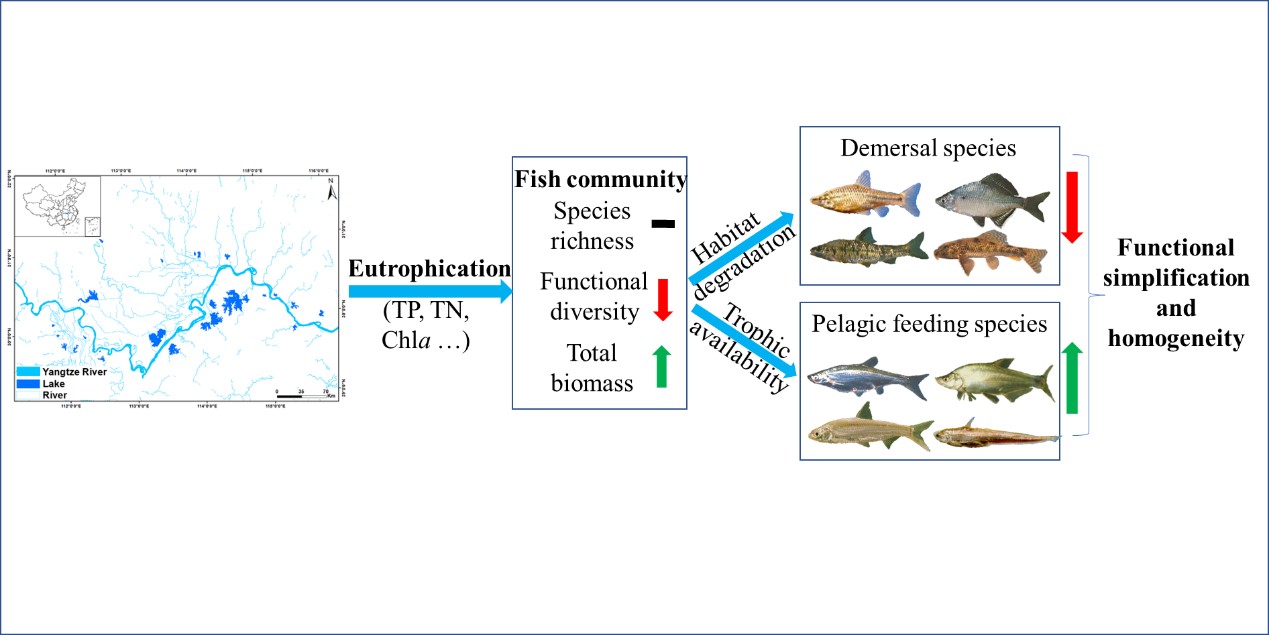
Newsroom
Lake Eutrophication Induces Functional Simplification and Homogeneity of Fish Community
Under the background of global climate change, multiple environmental pressures, such as over-exploitation of fish resources and degradation of aquatic ecosystems, are increasingly threatening the sustainable production of food in fishery waters and health of aquatic ecosystems. Among them, the rapid accumulation of nutrients caused by human activities has led to extensive ecological problems in aquatic ecosystems, and the resulting eutrophication has greatly changed the global fish communities.
Fish communities are composed of species with different functional traits, which determine the growth, survival, feeding, reproduction, and behavior of a species under specific biotic and abiotic environmental conditions. Functional traits reflect the interaction between species and abiotic environmental factors and organisms, and directly affect the structure and function of ecosystems. However, few studies have explored how eutrophication acts as an important environmental filter on functional traits and functional structure of fish communities.
A collaborative study led by Associate Prof. WANG Qidong from the Institute of Hydrobiology (IHB) of Chinese Academy of Sciences and Prof. HUGUENY Bernard from University Toulouse III - Paul Sabatier in France carried out quantitative observations from 2017 to 2019 in 26 shallow lakes located in the Jianghan Lake Group in the Yangtze River Basin, and revealed lake eutrophication induces functional simplification and homogeneity of fish community. The study was published in Science of the Total Environment.
Firstly, the researchers studied the effects of eutrophication on taxonomic diversity, functional diversity of fish community. The results showed that on the one hand eutrophication leads to an increase in total fish biomass and a decrease in functional diversity, but it has little effect on species richness. On the other hand, the relative abundance of different species changes, and the dominance of a few species increases significantly.
The researchers then revealed the changes in the functional structure of fish communities in terms of fish life history strategies, feeding nutrition, and habitat selection. Habitat degradation due to eutrophication, especially events such as biological clogging and benthic water hypoxia, has resulted in declining of many species relying on gravel habitats (e.g., Abbottina rivularis) or bivalves for reproduction and parental care behaviors (e.g., Acheilognathinae and Sarcocheilichthys nigripinnis). At the same time, eutrophication has significantly changed the food resources and nutrient structure of the lake, especially the abundance of pelagic species that feed on zooplankton (e.g., Toxabramis swinhonis) or small fish (e.g., Chanodichthys dabryi) in the lake.
The findings of this study were also compared with related studies in Europe, the region with the most researches on the effects of eutrophication on lake fish communities in the world. The results showed that lake eutrophication in China and Europe had different effects on the trophic structure of fish communities, highlighting the important role of fish fauna differences caused by specific evolutionary histories in understanding how fish communities respond to environmental stresses.
This study confirms that eutrophication is an important factor affecting the structure of fish communities. Specifically, eutrophication reduces the diversity of species more affected by habitat degradation through environmental filtering and increases functional trait homogeneity in tolerant species, leading to functional simplification of fish communities. This study provides a scientific basis for the continuous recovery and community regulation of eutrophic lakes.
